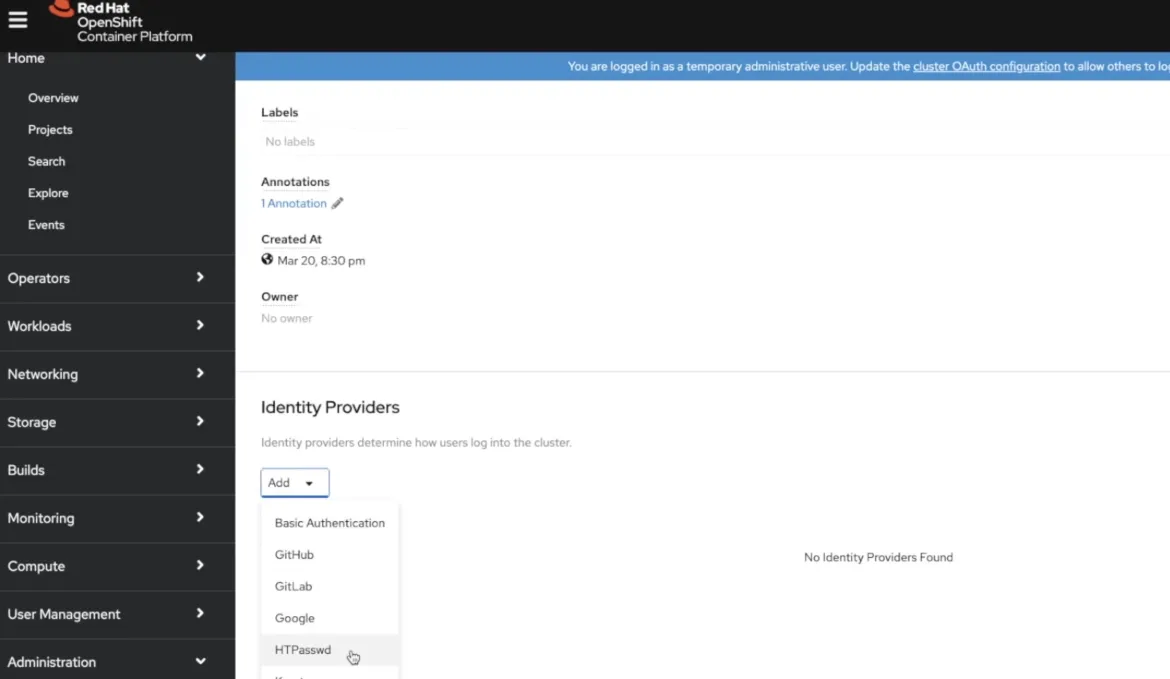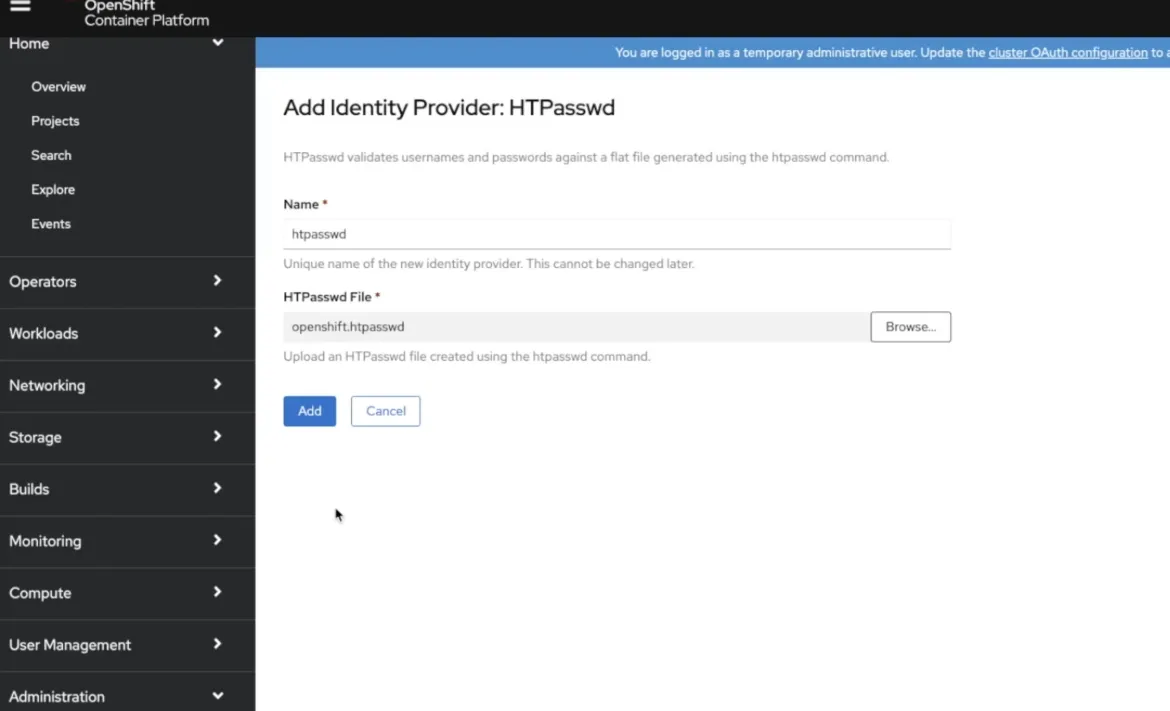Red Hat OpenShift is an enterprise-ready Kubernetes platform that offers many powerful features that meet today's enterprise needs. For example, one feature of OpenShift is its flexible way of integrating with different authentication mechanisms, whether basic authentication, LDAP, Active Directory, OpenShift login, GitHub login, and so on.
As you start OpenShift the first time, you might find it super easy to leverage the htpasswd utility, which is a built-in tool for most Linux distributions and macOS. This article demonstrates how you can create your own htpasswd file and add it to Red Hat OpenShift through an intuitive web interface.
[ Readers also liked: 5 reasons why you should develop a Linux container strategy ]
You can also follow this video that shows the video demo walking through the steps.
STEP 1: Create an htpasswd file
The command to create a new htpasswd file is shown below:
htpasswd -c -B -b <file name to store HTPASSWD> <username> <password>
You have to replace file name to store HTPASSWD, username, and password values with your own values.
Once the file is created, you can omit the -c option to simply append each username and password to the htpasswd file.
STEP 2: Load htpasswd file from OpenShift
In your Red Hat OpenShift, log in as one of the users with a cluster-admin privilege. Please follow these steps:
- Click Administration on the left menu
- Select Cluster Settings
- Select the Global configuration tab
- Scroll down to select OAuth
- Select the HTPASSWD option
- Select the file


You should be able to find the htpasswd converted to an OpenShift Secret under the openshift-config namespace.
Log out and verify you can login with the htpasswd option
Now, everything is set up. Just log out and find a new selection that indicates the htpasswd login option.

[ Deploy an application with Red Hat OpenShift Service on AWS - Overview: How to deploy an application using Red Hat OpenShift Service on AWS. ]
Wrap up
If you're interested in learning how to automate the process to add multiple users to the htpasswd file, please check out this video that demonstrates a simple Bash script that I wrote. OpenShift is very flexible in integrating with different authentication mechanisms, which include basic authentication, LDAP, Active Directory, OpenShift login, GitHub login, and others.
저자 소개
Bryant Jimin Son is a Consultant at Red Hat, a technology company known for its Linux server and opensource contributions. At work, he is working on building the technology for clients leveraging the Red Hat technology stacks like BPM, PAM, Openshift, Ansible, and full stack development using Java, Spring Framework, AngularJS, Material design. Prior to joining Red Hat, Bryant was at Citi Group's Citi Cloud team, building the private Infrastructure as a Service (IaaS) cloud platform serving 8,000+ teams across Citi departments. He also worked at American Airlines, IBM, and Home Depot Austin Technology Center. Bryant graduated with Bachelor of Sciences in Computer Science and Aerospace Engineering with minor concentration in Business at University of Texas at Austin.
He is also the President and Founder of Korean American IT Association group, known as KAITA (www.kaita.org). He is an avid coder spending extra time on building side projects at cafes, and he travels every week on business. He also loves to work out daily and to grow KAITA.
채널별 검색
오토메이션
기술, 팀, 인프라를 위한 IT 자동화 최신 동향
인공지능
고객이 어디서나 AI 워크로드를 실행할 수 있도록 지원하는 플랫폼 업데이트
오픈 하이브리드 클라우드
하이브리드 클라우드로 더욱 유연한 미래를 구축하는 방법을 알아보세요
보안
환경과 기술 전반에 걸쳐 리스크를 감소하는 방법에 대한 최신 정보
엣지 컴퓨팅
엣지에서의 운영을 단순화하는 플랫폼 업데이트
인프라
세계적으로 인정받은 기업용 Linux 플랫폼에 대한 최신 정보
애플리케이션
복잡한 애플리케이션에 대한 솔루션 더 보기
오리지널 쇼
엔터프라이즈 기술 분야의 제작자와 리더가 전하는 흥미로운 스토리
제품
- Red Hat Enterprise Linux
- Red Hat OpenShift Enterprise
- Red Hat Ansible Automation Platform
- 클라우드 서비스
- 모든 제품 보기
툴
체험, 구매 & 영업
커뮤니케이션
Red Hat 소개
Red Hat은 Linux, 클라우드, 컨테이너, 쿠버네티스 등을 포함한 글로벌 엔터프라이즈 오픈소스 솔루션 공급업체입니다. Red Hat은 코어 데이터센터에서 네트워크 엣지에 이르기까지 다양한 플랫폼과 환경에서 기업의 업무 편의성을 높여 주는 강화된 기능의 솔루션을 제공합니다.

